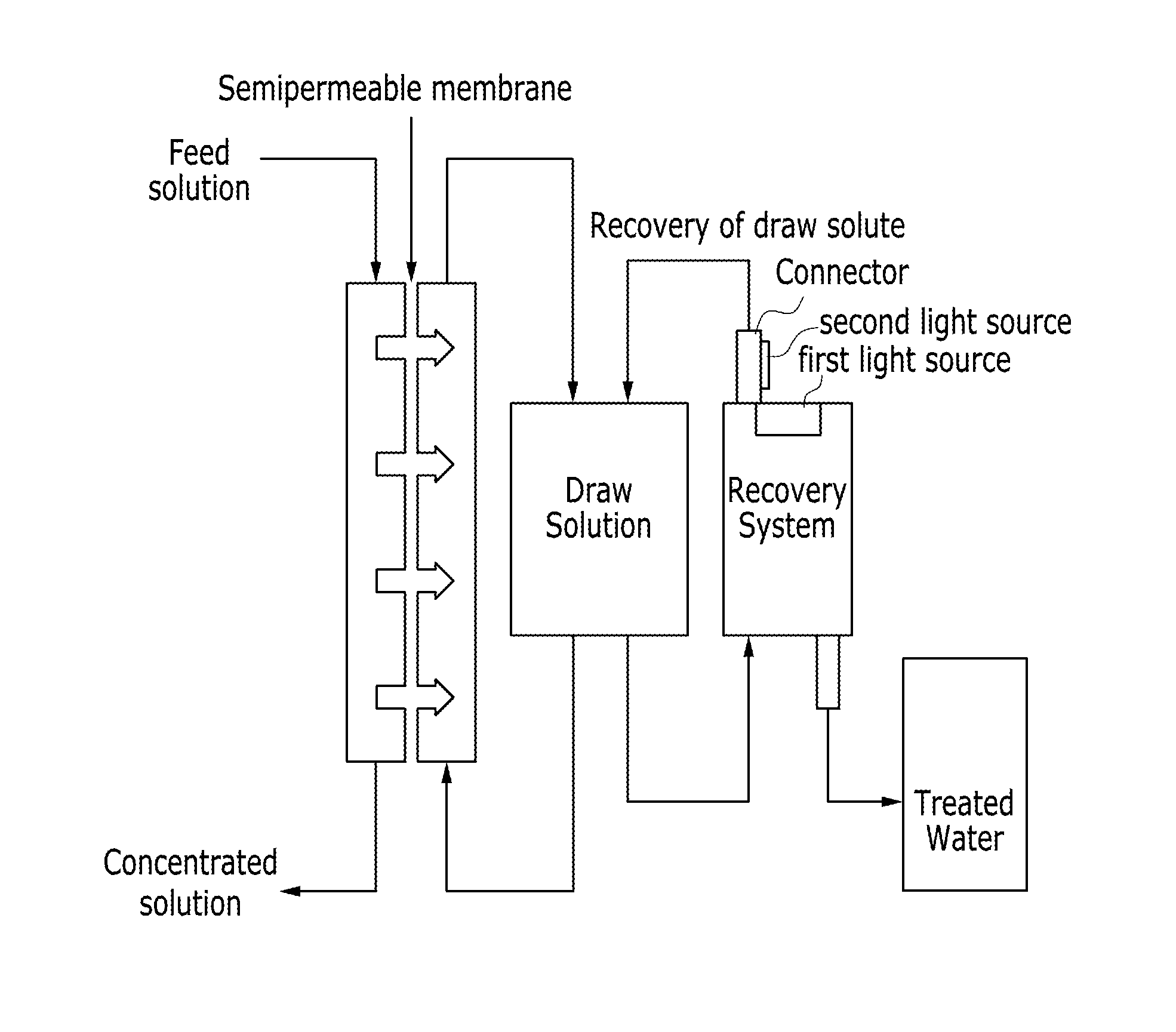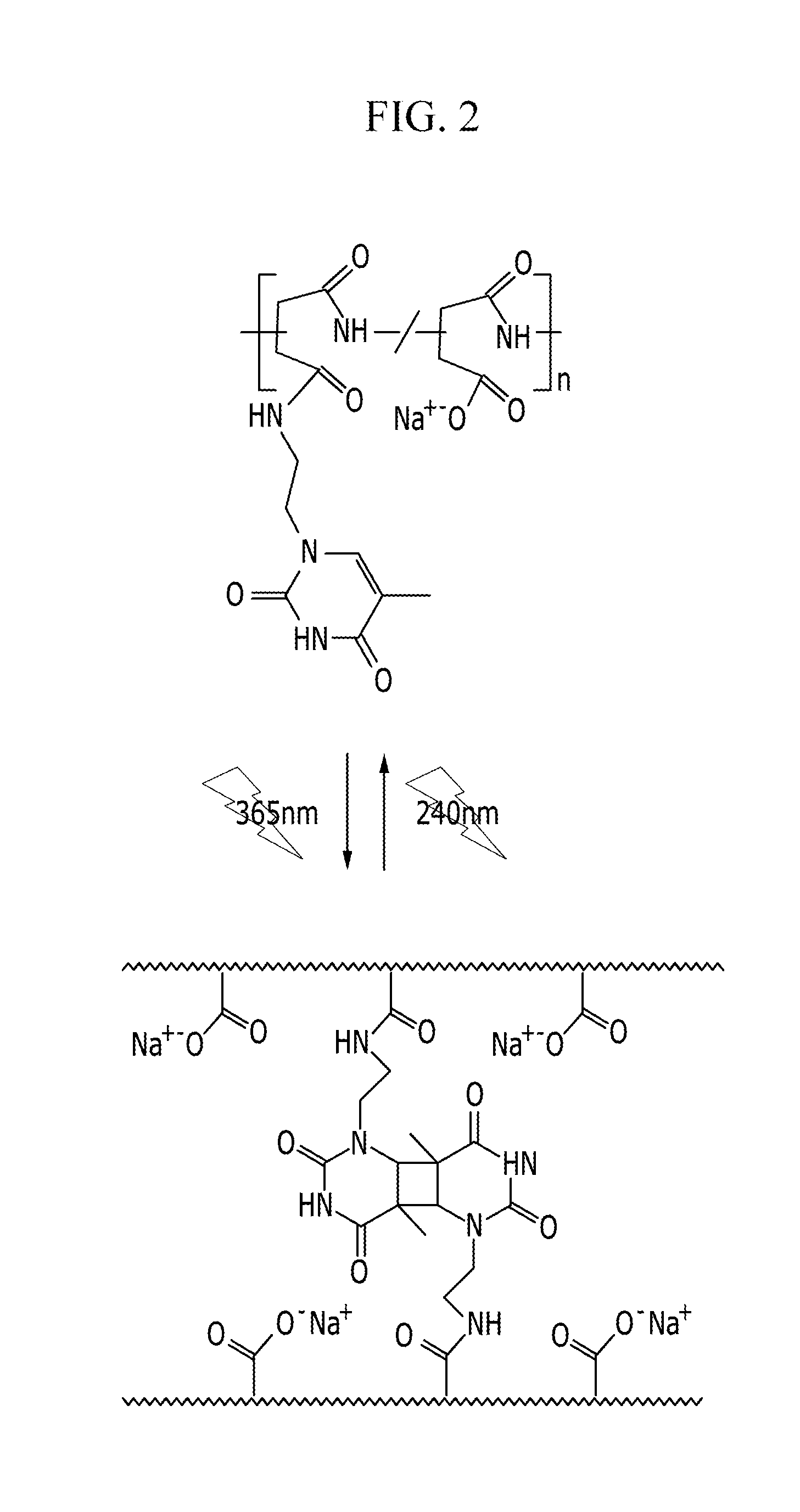Draw solutes and forward osmosis water treatment apparatuses, and methods using the same, and methods of producing draw solutes
a technology of forward osmosis water treatment and draw solutes, which is applied in the direction of multi-stage water/sewage treatment, membranes, separation processes, etc., can solve the problems of inability to use foregoing draw solutes for the process, consuming more energy in the reverse osmosis process, and consuming the most energy costs of separation and recovery of draw solutes, etc., to achieve low reverse salt flux, high osmotic pressure, and appropriate mo
- Summary
- Abstract
- Description
- Claims
- Application Information
AI Technical Summary
Benefits of technology
Problems solved by technology
Method used
Image
Examples
example 1
[0096]An aspartic oligomer containing a thymine moiety is synthesized via the Reaction Scheme of FIG. 5.
[0097]10 g of a succinimide oligomer (hereinafter, PSI, molecular weight: 2000 to 3000, purchased from Bayer Co. Ltd.) is dissolved in a mixture of dimethylformamide (DMF), and 0.5 mL of triethylamine and 6.1 g of bromoethyl hydrobromide (purchased from Sigma Aldrich Co. Ltd.) is added thereto. The resulting solution is heated to 70° C. and reacted for 24 hours. 4.54 g of thymine (purchased from Sigma Aldrich Co. Ltd.) and potassium carbonate (K2CO3, purchased from Sigma Aldrich Co. Ltd.) are added to the reaction product, and the resulting mixture is heated again to 70° C. and reacted for 24 hours to obtain a solution containing a partially ring opened product having a thymine moiety introduced thereto. 2.8 g of sodium hydroxide (purchased from Yakuri Pure Chemicals Co. LTD.) is added to the resulting solution and stirred at room temperature for 30 minutes. The reacted solution t...
example 2
[0099]An aspartic acid oligomer containing a coumarin moiety is synthesized in accordance with the reaction scheme of FIG. 8.
[0100]0.45 g of 7-amino-4-methylcoumarin (purchased from Sigma-Aldrich Co. Ltd.) is dissolved in 2.5 mL of dimethyl sulfoxide (DMSO) (purchased from Sigma-Aldrich Co. Ltd.) to obtain a coumarin solution. 5 g of PSI is dissolved in 10 mL of DMSO in a reactor, the coumarin solution is added to the reactor, and then 0.8 mL of triethylamine (purchased from Sigma-Aldrich Co. Ltd.) is added thereto and a reaction proceeds at 70° C. for 24 hours.
[0101]125 mL of a NaOH aqueous solution (1.95 g of NaOH, purchased from Sigma-Aldrich Co. Ltd.) is added to the resulting solution, which is then reacted at room temperature for another 12 hours. After the completion of the reaction, methanol (purchased from Sigma-Aldrich Co. Ltd.) is added to form a precipitate, which is then subjected to centrifuge. The separated product is vacuum dried at a temperature of 100° C.
example 3
[0102]An aspartic acid oligomer containing an anthracene moiety is synthesized in accordance with the reaction scheme of FIG. 9.
[0103]0.5 g of 2-aminoanthracene (purchased from Sigma-Aldrich Co. Ltd.) is dissolved in 2.5 mL of dimethyl sulfoxide (DMSO) (purchased from Sigma-Aldrich Co. Ltd.) to obtain an aminoanthracene solution. 5 g of PSI is dissolved in 10 mL of DMSO in a reactor, the coumarin solution is added to the reactor, and then 0.8 mL of triethylamine (purchased from Sigma-Aldrich Co. Ltd.) is added thereto and a reaction proceeds at 70° C. for 24 hours.
[0104]125 mL of a NaOH aqueous solution (1.95 g of NaOH, purchased from Sigma-Aldrich Co. Ltd.) is added to the resulting solution, and reacted at room temperature for another 12 hours. After the completion of the reaction, methanol (purchased from Sigma-Aldrich Co. Ltd.) is added to form a precipitate, which is then subjected to centrifuge. The separated product is vacuum dried at a temperature of 100° C.
PUM
| Property | Measurement | Unit |
|---|---|---|
| wavelength | aaaaa | aaaaa |
| wavelength | aaaaa | aaaaa |
| osmotic pressure | aaaaa | aaaaa |
Abstract
Description
Claims
Application Information
 Login to View More
Login to View More - R&D
- Intellectual Property
- Life Sciences
- Materials
- Tech Scout
- Unparalleled Data Quality
- Higher Quality Content
- 60% Fewer Hallucinations
Browse by: Latest US Patents, China's latest patents, Technical Efficacy Thesaurus, Application Domain, Technology Topic, Popular Technical Reports.
© 2025 PatSnap. All rights reserved.Legal|Privacy policy|Modern Slavery Act Transparency Statement|Sitemap|About US| Contact US: help@patsnap.com



